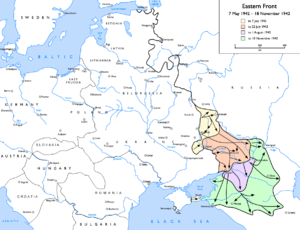- Operation Edelweiss
-
Naval warfare
Baltic Sea - Black Sea - Arctic - (Arctic Convoys - Rösselsprung - Wunderland)
1941
Barbarossa - (Białystok and Minsk - Smolensk - Uman - Leningrad - 1st Kiev - Sevastopol - Rostov - Moscow) - Finland - Chechnya
1942
Battles of Rzhev - (Toropets and Kholm - Demyansk - Velikiye Luki - Mars) - 2nd Kharkov - Case Blue - Stalingrad - (Uranus - Winter Storm)
1943
3rd Kharkov - Kursk - 2nd Smolensk - Lower Dnieper - 2nd Kiev
1944
Dnieper and Carpathian - Leningrad and Novgorod - Narva - Hube's Pocket - Crimea - Jassy-Kishinev - Karelia - Bagration - Lvov and Sandomierz - 2nd Jassy-Kishinev - Baltics - Debrecen - Petsamo and Kirkenes - Hungary
1945
Vistula and Oder - East Prussia - East Pomerania - Solstice - Silesia - Vienna - Berlin - Czechoslovakia - German capitulationBlue – Voronezh – Drive to Caucasus – Caucasus – Drive towards Stalingrad – Stalingrad – 3rd KharkovOperation Edelweiss (German: Edelweiß), named after the mountain flower, was a German plan to gain control over the Caucasus and capture the oil fields of Baku during the Soviet-German War. The operation was authorised by Hitler on 23 July 1942. The main forces included Army Group A commanded by Wilhelm List, 1st Panzer Army (Ewald von Kleist), 4th Panzer Army (Colonel-General Hermann Hoth), 17th Army (Colonel-General Richard Ruoff), part of the Luftflotte 4 (Generalfeldmarschall Wolfram Freiherr von Richthofen) and the 3rd Romanian Army (General Petre Dumitrescu). Army Group A was supported to the east by Army Group B commanded by Fedor von Bock and by the remaining 4th Air Fleet aircraft (1,000 aircraft in all). The land forces, accompanied by 15,000 oil industry workers, included 167,000 troopers, 4,540 guns and 1,130 tanks.
Contents
Preparations
Several oil firms such as "German Oil on Caucasus", "Ost-Öl" and "Karpaten-Öl" had been established in Germany. They were awarded an exclusive 99-year lease to exploit the Caucasian oil fields. For this purpose a large number of pipes, which later proved useful to the Soviet oil industry workers, were delivered. A special economic inspection "A", headed by Lieutenant-General Nidenfuhr was created. Bombing of the oil fields was forbidden. To defend them from destruction by Nikolai Baibakov and Semyon Budennyi, an SS guard regiment and a Cossack regiment were formed. The head of Abwehr developed Operation Grozny, Malgobek and Maikop regions. They would be supported by the local fifth column.
Operation
Main article: Battle of the CaucasusAfter neutralizing the Soviet counter-attack in the Izyum-Barvenkovsk direction the German Army Group B rapidly attacked towards the Caucasus. When Rostov-on-Don, nicknamed "The Gates of Caucasus," fell on 23 July 1942 the tank units of Ewald von Kleist moved across the Caucasian Mountain Range. The "Edelweiss" division commander, Hubert Lanz, decided to advance through the gorges of rivers of the Kuban River basin and by crossing the Marukhskiy Pass (Maly Zelenchuk River), Teberda, Uchkulan reach the Klukhorskiy Pass, and simultaneously through the Khotyu-tau Pass block the upper reaches of the Baksan River and the Donguz-Orun and Becho passes. Concurrently with the outflanking maneuvers, the Caucasian Mountain Range was supposed to be crossed through such passes as Sancharo, Klukhorskiy and Marukhskiy to reach Kutaisi, Zugdidi, Sukhumi and Tbilisi. The units of the 4th German Mountain Division, manned with Tyroleans, were active in this thrust. They succeeded in advancing 30 km toward Sukhumi. To attack from the Kuban region, capture the passes that led to Elbrus, and cover the "Edelweiss" flank, a vanguard detachment of 150 men commanded by Colonel-General Grott was formed. From the Old Karachay through the Khurzuk aul and the Ullu-kam Gorge the detachment reached the Khotyu-tau Pass, which had not been defended by the Soviet troops. Khotyu-tau gained a new name — "The Pass of General Konrad".
The starting point of the operation on the Krasnodar-Pyatigorsk-Maikop line was reached on 10 August 1942. On 16 August the battalion commanded by von Hirschfeld made a feint and reached the Kadar Gorge. On 21 August a Nazi flag was installed on Mount Elbrus, the highest point of the Caucasus.
See also
External links
Bibliography
- Nick Michael. Operation Edelweiss: The most audacious mission of World War Two.
- (Russian) Иван Тюленев. Крах операции "Эдельвейс". Орджоникидзе, 1975.
- (Russian) К.-М. Алиев. В зоне "Эдельвейса". М.-Ставрополь, 2005.
Categories:- Germany-centric
- History of the Caucasus
- Military operations of World War II involving Germany
- Battles and operations of the Soviet–German War
Wikimedia Foundation. 2010.

